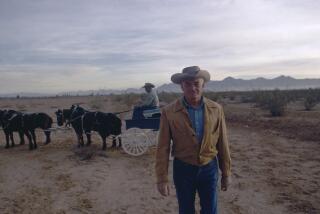Storyteller Keeping Arizona’s Past Alive
- Share via
GLENDALE, Ariz. — In a state where the desert scenery disappears daily with each new tract home, historian Marshall Trimble is a keeper of days gone by.
Complete with black cowboy hat, guitar strapped over his shoulder and harmonica around his neck, Trimble uses cowboy songs and tales--some tall and some true--to entertain about 150 audiences a year.
His 16 books and countless stories about Arizona have earned him the official title of state historian, though not a state paycheck. He gets that through his teaching position at Scottsdale Community College, where he teaches Arizona history and folklore.
“I’m not particularly concerned with how much detail they remember. I want them to like the material,” Trimble says of the thousands who hear him speak. “I want them to say ‘His stories gave us a love for the American West.’ ”
To that end, he acknowledge some of his tales aren’t exactly true--like the one he tells a group of squirming children in the Pioneer Elementary School library this October day.
He starts by showing the children a black-and-white drawing of an Arizona “chip seal,” as the grade schoolers crane their necks to catch a peek.
Millions of years ago, he says, Arizona was covered with water, but when it receded to California, not all the ocean animals wanted to leave.
A few seals were bound and determined to stay. But without any water, they shrunk to itty-bitty animals, about the size of a pebble, he says, leaning toward the microphone. And when the wagons came, they squished the little chip seals, paving all of Arizona, he says as the children giggle.
“Now, in desperate pleas to save their lives, they fly into your windshield,” he says, grinning, his tall tale in full bloom. “They don’t mean any harm. They are just trying to warn people.”
Even with 150 speaking engagements a year, Trimble faces an uphill battle trying to educate Arizonans about their history. Only a third of the people living here were natives in 1990, the latest U.S. Census figures show, and the state’s population continues to grow.
“We have such a transient population. The place is booming. A lot of people are coming to make money, not to get the ambience of the place. That comes later,” Trimble says.
Even Trimble, an Arizona native, says he is constantly picking up new stories and was surprised at how little he knew when he took his first Arizona history class.
Trimble was born on a ranch south of the Phoenix area, reared the son of small-time ranchers. (“There were hardly enough cows for a family barbecue.”)
His parents migrated here from Texas for health reasons. Like many other Arizonans, they were told the arid climate was a haven for those with respiratory illnesses.
His father was an old cowboy storyteller, Trimble says, so he figures he picked up the art from him. He used that art to teach high school history before taking a position in 1972 at Scottsdale Community College, teaching Arizona history and folklore.
“Some people collect stamps. Some people collect coins. I collect stories,” he says.
Gary Shaffer, a longtime colleague of Trimble’s at Scottsdale Community College, says Trimble is full of stories about every corner of Arizona.
“Everywhere we go he’s reminded of things,” Shaffer says. “He paints [Arizona history] in a tremendously exciting light.”
But Shaffer, an anthropology instructor, says Trimble is not above trying to pass a tall tale off as historical fact.
“He’ll mess with you, but he won’t ever lie to you,” Shaffer says with a chuckle.
At 59, Trimble, a quintessential cowboy down to his wiry build and leather boots, says he’s watching for a successor.
“I keep looking out there for some young man or woman who can light up a crowd, so I can ride off into the sunset someday,” he says with a laugh.
He already knows what he wants his tombstone to say: “He never wrote for his critics,” or “He always kept his day job.”
Or both.
More to Read
Sign up for The Wild
We’ll help you find the best places to hike, bike and run, as well as the perfect silent spots for meditation and yoga.
You may occasionally receive promotional content from the Los Angeles Times.






